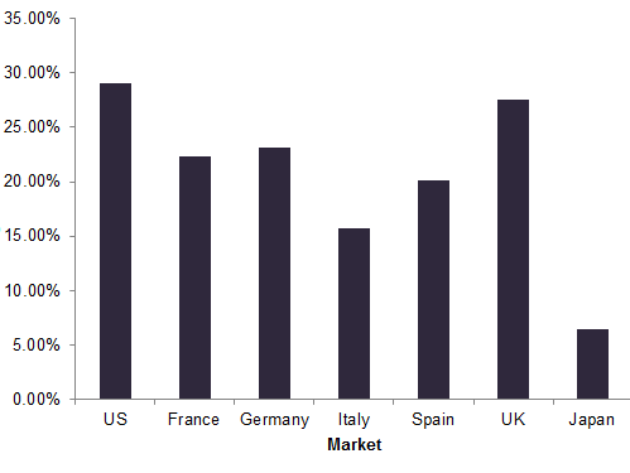
The two main strains of Clostridium difficile typically produce two toxins called toxin A and toxin B. However, many of the severe strains of C. difficile have been shown to produce a third toxin called binary toxin, or CDT. This toxin has been associated by some with more severe cases and resistance to treatment. In the US and the UK, the percentage of C. difficile infections (CDI) that were positive for CDT in 2016 amounted to nearly 30%. But in Japan, only 6.5% of CDI cases were CDT-positive. Meanwhile, that percentage ranged from 15% to 23% in France, Germany, Italy, and Spain. Figure 1 shows the percentage of CDI cases that were CDT-positive in the seven major markets (7MM: US, France, Germany, Italy, Spain, UK, and Japan) in 2016. The US and UK have the highest percentages of CDT-positive CDI cases.
Figure 1: Percentage of CDI Cases that Are Positive for Binary Toxin (CDT), 2016

CDI cases typically cause watery diarrhea, anorexia, and nausea. In severe cases, CDI can result in shock, ileus, or toxic megacolon. CDI cases are most common in patients with recent antibiotic use or overnight stays in healthcare facilities. In addition to antibiotic use and hospitalisation, advanced age is a major risk factor for contracting CDI.
Since 2001, particularly dangerous strains of C. difficile have caused outbreaks of severe CDI with greater resistance to usual therapy. While some studies have suggested CDT could cause more severe disease and resistance to treatment, the direct effect of CDT is not fully understood. Nonetheless, this remains an important part of current CDI research.
See Also:
Using data obtained from country-specific registries and peer-reviewed studies, GlobalData epidemiologists calculated the percentage of CDI cases that were CDT-positive. The high percentage of CDT-positive CDI cases in the US and the UK warrant special efforts toward surveillance of outbreaks, infection control, and antibiotic stewardship in these countries. Antibiotic stewardship and infection control can play a key role in limiting the number of new infections, while thorough surveillance of outbreaks can help inform containment strategy.
How well do you really know your competitors?
Access the most comprehensive Company Profiles on the market, powered by GlobalData. Save hours of research. Gain competitive edge.

Thank you!
Your download email will arrive shortly
Not ready to buy yet? Download a free sample
We are confident about the unique quality of our Company Profiles. However, we want you to make the most beneficial decision for your business, so we offer a free sample that you can download by submitting the below form
By GlobalData
Details about the trend analysis and other discussions of CDI epidemiology can be found in GlobalData’s EpiCast Report: Clostridium difficile Infection (CDI) – Epidemiology Forecast to 2026 and EpiCast Model: Clostridium difficile Infection (CDI) – Epidemiology Forecast to 2026.



